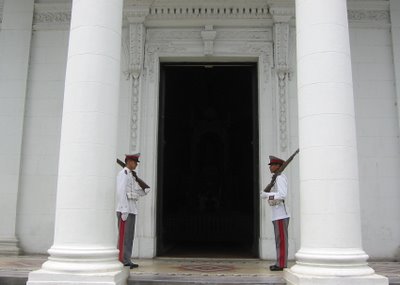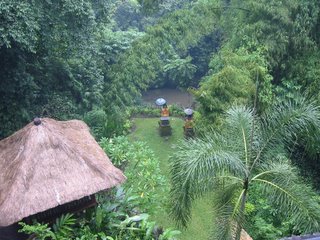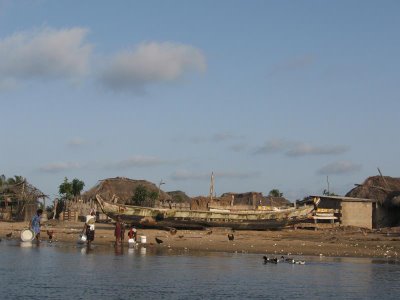
I wouldn't recommend this, but Americans do travel to Iraq. I went out of my way to miss Iraq several times-- starting in 1969-- because I never had the feeling it was a safe place for Americans. And since Bush invaded and occupied the country and presided over the slaughter of tens of thousands of innocent civilians, the complete breakdown of civil society and the onset of a catastrophic civil war... it's no exaggeration to say it's considerably less safe.
One of my friends, Fred, is over there working. I tried to talk him out of it but he feels he owes the Iraqi people the completion of an important project that has been utterly botched by the incompetent and larcenous Bush Regime, a completion that will require his unique expertise and dedication. From time to time Fred sends me stories about life in the Greed Zone and I post that at Down With Tyranny. Today's installment talks less about politics and more about how one physically gets from Amman (or Kuwait) into Baghdad. I thought I'd share that part, although I recommend the whole piece for, at the very least, context-- like knowing water will be hard to come by and that there are some natives who may be less than friendly towards Americans for some reason.
Traveling to Baghdad under US Government auspices is a dilly of an experience. It was so fascinating that I took notes along the way. After arriving, everything seemed so surreal that I continued taking notes. I was here in mid-2004 but somehow I either was not exposed to the more weird aspects of life in the Green Zone or did not notice it. Anyway, here is the first part of my story for your amusement.
It took 20 hours to get to Baghdad by plane from Amman, Jordan. Prewar, one could drive it in about ten hours. The trip was bizarre to say the least. I even had written instructions and tried to follow them to the letter but alas, a few things were left out.
The delays started even before travel begins. Someone in Baghdad must first verify that you have a CAC or Common Access Card, country clearance, a Letter of Authorization (LOA, at the airport they referred to them as Travel Orders) and that there is room for you in the inn, i.e. is there an empty bunk in one of the several thousand trailers or other billets in the International Zone (better known as the Green Zone)? None of this happens in parallel, all must be done in a specific sequence. When all is gathered, a seat is reserved for you on a C-130.
Two days a week, a C-130 flies from Kuwait to Baghdad, then Baghdad to Amman, then Amman back to Baghdad and finally from Baghdad back to Kuwait; all very orderly, but intentionally (for security reasons) not on any discernable time schedule.
On the afternoon before the flight, specifically between the hours of 4 and 8 pm, you are obliged to telephone (or inquire via the Internet) the transportation people and ask for the Amman to BIAP (Baghdad International AirPort) ‘show time’. I telephoned at the appointed time and was told that show time at Marka airport-– an old airport now mostly devoted to general aviation-– was “oh-nine-thirty.”
At 8:15 the following morning, a colleague drove me to the airport. On the drive, I mused that the usually brown hills had turned green as the result of a tiny bit of rain a few days earlier and thought of it as a good sign. Such is life in a desert environment.
Marka airport dates from an earlier era. The terminal looks as though it had just slipped into a hole in the ground. It is small, nearly empty, dimly lit and dreary. Other than the employees, everyone in the terminal appeared to be headed for the same flight to Baghdad.
After standing in line for an hour, I paid the departure tax, gave someone at the ticket counter (no tickets were actually issued) my luggage bag and a copy of my LOA and was checked in. One carry-on is permitted – as long as you can carry it on your lap.
After checking in, we passengers gathered in a small open area overlooking part of the runway and waited some more. A forlorn looking Duty Free shop was open as was a stand that sold cookies, sodas and such but otherwise the joint was empty.
After a rather long wait, Jordan Immigration opened a departure counter and someone called out that the immigration line was open. So, I had the dubious pleasure of yet another line in which to stand. Having completed that task, everyone re-gathered into a glassed-off waiting area and, of course, waited some more.
At 12:45 pm, a bus pulled up and after more waiting, a group of us crowded onto the bus and were taken to the plane. This being a C-130 we boarded by walking up a ramp at the back of the plane. The seats are web mesh on aluminum frames. Down each side of the plane a row of seats faces inward; down the center of the plane two rows of seats separated by web mesh faces outward. I’ve attached pictures for your amusement.
The web mesh is the seat back. For those sitting in the middle rows of seats only the mesh separates each persons back from the back of the person on the other side. The plane narrows in the middle to accommodate the wheel wells. Passengers seated in that section find themselves sharing knee space as well. Amazingly enough, several passengers seemed to sleep or toil away (play?) on laptops that were truly on their laps, despite the rather uncomfortable arrangement. When one of the air force types (shall I call him the flight attendant?) went from the front of the plane to the back, he did so by stepping carefully between the knees of the passengers from one seat edge to the next.
Some 70 of us crowded onto the plane. The toilet on the plane is a bucket behind a curtain, if anyone is desperate for relief.
Our baggage, collected on a pallet and wrapped in plastic wrap like a piece of meat at the supermarket, was fork-lifted onto the plane, the ramp raised, the door latched and off we went. The plane jerked forward from a standing position but climbed into the sky quite nicely. The flight was noisy and uncomfortable but not overly long.
At 1:54 pm, the pilot landed the plane in a spiral motion-– rather reminiscent of the time I did my pilot’s biennial with a stunt pilot as my check pilot. In this case however, the reason for landing in such an unusual way was to avoid flying over areas where the troublemakers like to shoot at low flying planes. Touchdown was rather sudden and abrupt.
Even leaving the plane is an experience. First the luggage pallet is removed – we probably could not get off the plane otherwise – then a hippy-looking chap yelled “skull caps off” and “follow me." We stumbled off the plane, in two remarkably straight lines, for some distance behind the plane. The reason was immediately obvious. The engines were still running, the noise was deafening and the wind the engines generated was incredible. We next pushed off to a tent/building where our arrival was registered.
I was instructed to call upon arrival at BIAP but told not to give any flight times, etc. over the phone (seemed strange as the flight was over) but I followed the instructions. I had to borrow a phone as my Jordanian phone did not work despite receiving a SMS message welcoming me to Iraq from Fastlink Jordan.
It is not obvious where the luggage is placed upon arrival, and given the impression I had that the bags continued to the Green Zone with the passengers, I did not go fetch my bag-- a bit of a mistake-- but that’s another story.
For most folks who arrive on a C-130, getting to the Green Zone from BIAP is via steel-plated buses called Rhinos. The color, size and hulking shape of these beasts suggest that they are well-named. Unfortunately the Rhinos do not run until the wee hours of the morning (to avoid being shot at during the daytime, when folks can be along the road without appearing suspicious). So for those of us who arrived via C-130, it’s a 6 to 10 hour additional wait.
Having time to kill, I went exploring. I found a Dining Facility (in Green Zone-speak, a DFAC) but they would not let me enter with my laptop (security has its own peculiar logic) and there was no place to store it safely. I found a PX (Post eXchange) and cluster of trailers housing a Burger King, a Subway sandwich shop, a Green Beans (a Starbucks-like coffee shop found on military bases), a jewelry shop, a barber shop, a beauty salon and a gift shop. All seemed in the middle of nowhere, surrounded by churned up and hardened mud with large river stones in place of paving. The whole business was surrounded by concrete T-walls (blast protection).
Later I took a bus to Camp Striker (where the Rhinos pick up their passengers). The bus was accompanied by a van onto which they place any luggage that passengers are carrying (again, all in the name of security). At Striker, the waiting area is housed in a large temporary building with coffee, tea, television, and wireless internet (for a fee), etc. For those who can tolerate endless propaganda there are some couches and chairs around a couple of televisions with identical smatterings of Fox News and military pep talk pieces. There are also a few books and magazines to read.
At about 11:00 pm, the Rhino passengers queued up, identified themselves and had their names placed on a manifest and were told the number of the bus that they are to take to the Green Zone. Rhino passengers are required to have a flak jacket and helmet. Of course I did not have these items (and did not get any for several days). But I did receive a lengthy lecture on the subject. Just where, how or when I could have acquired this equipment was left out of the lecture.
The Rhinos finally arrived, an announcement was made and we we went out to meet them. The luggage was lined up in a row and sniffer dogs examined them after which the baggage and other boxes were tossed into a shipping container that sat on a flat bed trailer.
Five or six Rhinos (one purposefully empty) took us to the Green Zone. We were escorted by humvees with a pair of helicopters watching overhead. At the Green Zone, the luggage truck was unloaded, and again inspected by other sniffer dogs.
I was not told beforehand that I would be going into the Palace that morning, and thus did not get the necessary temporary badge. By the time someone came to get me, the badge person had left and my escort and I had to wait until someone of higher rank arranged for a temporary badge. The badge was needed simply to let me pass through the Palace on my way to a “Transient Hootch”, Hootch being the name given to the sleeping quarters that are trailers or modified shipping containers. It is a Vietnamese word for huts that serve as living quarters. The US military borrowed the name from the Vietnamese during the Vietnam war and have used it ever since. Once a temporary badge was issued, my escort took me to Billeting, picked up a room key and finally, at 4:00 am I crawled into bed.
So, you see the waiting is unbelievable, especially when you realize that everyone who enters or leaves the airport via this process loses a day in entering and a day in leaving. The drag on individuals and the cost to the USG must be enormous. I think the C-130 holds about 70 people. My guess is that the people cost alone easily exceeds $500,000 each trip. My logic: each trip 65 to 75 people travel to Amman and 65 to 75 from Amman plus similar numbers going through Kuwait – each person loses 16 to 24 hours in traveling this short distance-- the average fee expended for the services of these people likely exceeds $1,000 per person per day (my estimate may even be low)-- add in the cost of the C-130s, the security personnel, the Rhinos, the escorts and the number soon staggers the imagination-- all this in the name of security.
The costs go on. You cannot just change planes in Amman or Kuwait and fly on to Baghdad. Thus folks other than the military who are traveling to Iraq for the US Government must of necessity be lodged in a hotel for a day or more until such time as they can continue their journey.
I don't think the Baghdad Tourism Department is paying John McCain to do tv ads for them. I'd have to guess John McCain is insane.
UPDATE: AND AIR TRAVEL WITHIN IRAQ IS NO BOWL OF CHERRIES EITHER
Tomorrow's Washington Post carries a report from Josh Partlow, a journalist stationed in occupied Iraq, Flying Standby On Air Baqubah: Sun, Sand, Fleas. Sounds like Josh didn't have any more of a pleasant time than my friend Fred did. He was at a forward operating base north of Baghdad and wanted to fly back to lovely, historic, scenic, cosmopolitan Baghdad on a Chinook helicopter. The day started with a little sandstorm.
At 9:30 p.m. I reported to the airport lounge-- a gravel lot with one wooden bench-- to wait for my flight to Baghdad. I had a relatively clear view of the moon. How sandy could it be?
It turns out that pilots who don't want to crash also don't want to fly through sand, so we were on "weather hold." Not canceled and not subjected to some defined delay, just on hold. In this purgatory, I tried to amuse myself. This was difficult. The waiting area apparently was prime habitat for the notorious Iraqi sand flea. I'm not sure they were sand fleas. I never saw them. I just felt their tiny bites again and again and again, in places both public and private. In between swats I would look up, see the moon and remark to a fellow traveler, "How sandy could it be?"
The hours passed. At midnight I peeled off in search of food. Say what you will about the inhumanity of 15-month tours and denying soldiers beer in a desert, there is one indisputable example of military kindness: "midnight chow." After a hamburger, fries and banana milk, I felt renewed. The moon looked good. I counted a couple of stars. But the hold still held firm. Around 3 a.m. we got the word: all flights canceled.
So he was on standby for the next day-- and it was "somewhere north of 110 degrees hot." And boring. "Thursday morning, my colleague in Baghdad had to postpone his flight out of the country because I hadn't returned, and I woke up wearing the same sweat-encrusted clothes I'd worn the past three days." He fantasized about dressing up like an Iraqi and taking a taxi through the war zone, which is basically all of Iraq except, sometimes, on U.S. bases. Eventually, because he knew someone who knew someone who had a 'copter, he made it back to the Green Zone. "Just after 7 p.m., with a thick red pelt of bites and clothes that could stand on their own, I was home. In 46 hours, I had traveled 37 miles. Walking would have been faster."































